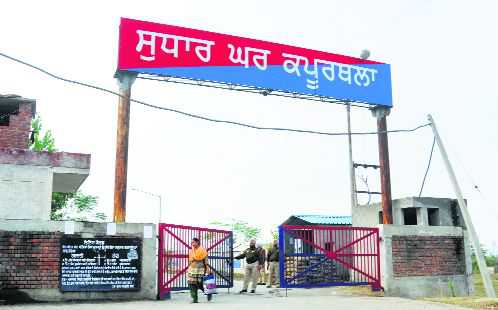
Problem: Kapurthala jail, built at a cost of Rs 190 crore, has faced a riot.
Upneet Lalli
Dy Director, Institute of Correctional Administration, Chandigarh
Prisons embody the power of the state over the liberty of the individual. Society may feel safe with incarcerating offenders, while shutting and forgetting what happens inside this opaque institute. The last wing of the criminal justice system comes into focus only when there is an escape or disturbance. More than 95 per cent of the offenders will be released back into society, so it is important to understand and reform the system which holds people who have broken the law as well as those who haven't.
Prison reform is an attempt to improve the system of legal punishment and conditions inside the prison. It also connotes establishing a more effective penal system and implementing alternatives to imprisonment. While the problems in prisons have been discussed for the last 120 years, changes have been slow and staggered. Numerous committees have been established to suggest changes, the seeds scattered have led to blooming of other committees. The All-India Jail Committee in 1920 had emphasised that reformation and rehabilitation of offenders should be the ultimate objective of prison administration.
Indian prisons continue to be governed by the Prison Act of 1894, largely based on deterrent principles with main focus on prison security and enforcement of discipline in prisons. This law did not have any focus on correction, reformation and rehabilitation of prisoners. The Act continues to remain the main law governing the management and administration of prisons in most states.
One of the most comprehensive works on prison reforms was done by the All-India Committee on Jail Reforms (1980-1983). It made 658 recommendations relating to not only prison living conditions but also legislation, system of classification, work programmes, organisational structure of prisons, etc. The latest committee to be set up as a result of the PIL regarding inhuman conditions in 1,382 prisons, wherein the Supreme Court has also passed various decisions dealing with four main problem areas — prison overcrowding, unnatural deaths, staff shortage and inadequate training of staff.
India has a prison population of around 4.20 lakh with around 67.2 per cent being undertrials. The problem of overcrowding exists in many states. Some other main problems relate to delay in trial, health and hygiene issues, poor living conditions, lack of education, vocational training and work programmes, staff shortage, lack of constructive time management, and no focus on reintegration.
Under the modernisation of prisons scheme, more than 100 new prisons were constructed in the country. The problem has been both with the design and location of the prisons. When design inculcates a carceral identity, it will not encourage positive change. Seeing the Bathinda Jail, having an authorised capacity of 2,100 constructed at a cost of nearly Rs 175 crore, I was shocked at the number of grills and bars placed even in the educational centre. Prisons for women do not present a threat to prison security and hence really do not require such high security prison architecture. Discussions with prison staff and inmates are also essential to know their needs and requirements. Green, sustainable prison model is being adopted in many countries.
The experience of countries, like the USA, has shown the failure of huge prison complexes. Prisons which are distant from the city result in problems for the visitors. The Central Jail at Kapurthala, with an authorised capacity of 3,000 was built at a cost of Rs 190 crore, faced a riot in the very first year of its opening. One of the factors for the riot was the fact that it was located far from the city and the visitors faced problems in meeting the inmates. The visiting rooms should promote human contact of inmates and their families. The selection of where new prisons should come up should also be based on crime projections and types of crimes in a particular area.
In many instances, newly constructed prisons were kept vacant for more than a year due to lack of vision and planning as no new staff were recruited to manage them. Technology upgradation, security surveillance, CCTVs and jammers, prison software management systems all are coming up, but without trained manpower, their maintenance become dysfunctional.
Structural reforms which relate to the Prison Act and the Rules and the Manual are another set of reforms that are much needed. Having contributed to framing the Punjab Prison Act in 2010 and then revising in 2015, I was most disappointed with the lack of political will and initiative to pass and implement the legislation which had spelled a new vision for prisons. The Model Prison Manual was made in 2000 and in 2016 following the Supreme Court directions. However, implementing the policy changes has been tardy.
The judiciary in the country has played an important role in ushering changes in prisons. Justice Krishna Iyer had in the landmark judgment of Sunil Batra emphasised on the humanitarian outlook of prisoners. The International Framework for Prisons has undergone many changes. The Mandella Rules of 2015 replaced the UN Standard Minimum Rules, 1955 while the Bangkok Rules of 2010 deal with issues of women prisoners and provide a blueprint of reforms. The invisibility of women in prisons (mere 4.3 per cent in India) leads to neglect of their issues. Prison reforms need a gender perspective as well.
However, no reform can be pushed from outside. There has been little discussion with the major stakeholders — the prisoners and the staff. Criminologist Gresham Sykes had warned against ignoring the "social system" inside prisons when attempting any kind of reform. Questions on the legitimacy of certain prison practices and regimes also arise. Without scientific classification, no-risk assessment prisoners are lodged on alphabetic system. The prison environment may be more criminogenic than reformative.
Prison regime should be built upon giving second chances and not just be warehouses with no social and purposive input. Time is the most difficult thing to manage in prisons. Less than 25 per cent of the convicts are involved in work programmes. Young offenders are the largest percentage of the prison population. Enforced idleness results in loss of skill and also deprives the prisoners the opportunity of earning for their families and contributing towards society. Successful re-entry requires pre-release planning, transitional services and community-based programmes. Re-entry has to be desistance focused and social support and social capital are critical factors for reintegration. Partnerships need to be developed.
It is also time that we make the prison walls 'permeable', by allowing the community to come and to participate in work and also allow prisoners to go out and do constructive work in the community. Restorative practices need to be used to promote ties between prisons and communities.
Research indicates that prisons are inherently damaging and do not serve the deterrence goal. An effective penal system should implement alternatives to imprisonment. Prison reforms are ultimately tied up with the reforms in the criminal justice system. Radical thinking is required along with future vision and planning, keeping in mind the present realities.
This is an edited extract of a presentation made at PDNS.
Views are personal.


























